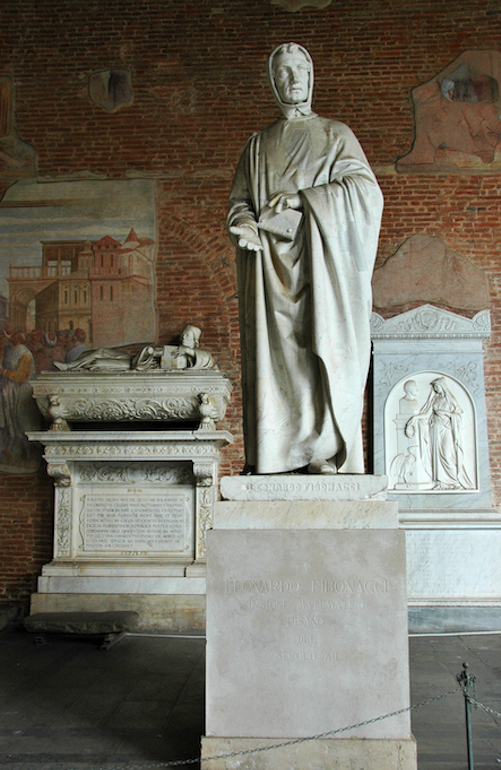
Have you heard of Fibonacci Day? This holiday celebrates Leonardo Bonacci, more commonly known as Fibonacci, one of the greatest mathematicians of the Middle Ages. Fibonacci is best known for authoringLiber Abaci(“The Book of Calculation”), which introduced the basis of modern arithmetic to the Western world. In celebration of this day, let’s take a look at five interesting facts about Fibonacci’s life and work.
1. He Was a Great Mathematical Expositor
Fibonacci’s exact place of birth is a mystery (similar to most of his childhood life), but he was likely born near Pisa, Italy, around 1170 (hence his moniker, Leonardo of Pisa). His father, Guglielmo, was a well-off Italian merchant, customs official, and director of a trading post in Bugia, now called Béjaïa,a Mediterranean port in northeastern Algeria. Unfortunately, little is known of Fibonacci’s mother, who passed away when he was nine.

This marble statue of Leonardo da Pisa located in Pisa, Italy, was completed by Giovanni Paganucci in 1863. It is likely that this statue is an artist’s conception of Fibonacci, as there is little known of his physical appearance. Image by Hans-Peter Postel and licensed underCC BY 2.5, viaWikimedia Commons.
Fibonacci was educated in Bugia, which is where he first learned of the Hindu-Arabic numeral system. He soon realized that arithmetic with Hindu-Arabic numerals was muchsimpler and more efficient than with Roman numerals. Later, in 1202, he published his findings in one of his more popular works,Liber Abaci,which popularized the Hindu-Arabic numerals in Europe. He published an expanded edition of this work in 1228, which is the version we are familiar with today. InFinding Fibonacci, a biography on Fibonacci, author Keith Devlin said (Ref. 1):
“The invention Leonardo had written about was a remarkable new way of writing numbers and calculating them. So remarkable and complete would be the transformation of human life brought about by this new system that generations that came long after him would eventually take it for granted, relegating numbers and arithmetic to a tedious but necessary routine chore that had to be learned by repetition (or, for later generations still, left to machines). It is the system for writing numbers and doing basic arithmetic that is taught in schools today the world over. By making that system available to western European businessmen, Leonardo’sLiber Abaciwould play a major role in creating the modern world.”
His other published works includePractica Geometriae(“The Practice of Geometry”) andLiber Quadratorum(“The Book of Square”). Thanks to such works, it was apparent that Leonardo had a real talent for explaining mathematical concepts.
2. He Was Forgotten for 400 Years
During his lifetime, Fibonacci grew to become a highly respected and well-known mathematician. In Italy, he was even regarded as an icon. However, after he passed away circa 1240, his name eventually disappeared from the pages of any writing on the history of mathematics.
It wasn’t until the late 18thcentury that his name finally resurfaced. When reading throughSumma de arithmetica, geometria, proportioni et proportionalita(“Summary of arithmetic, geometry, proportions and proportionality”), written by the famous mathematicianLuca Pacioli, mathematician Pietro Cossali noticed a name he had not heard before.
That name, as you may have guessed, was Leonardo Pisano (aka Fibonacci). Cossali was curious to know more about the mystery math man. After researching the name, Cassoli realized just how important of a role Fibonacci played in the spread of modern arithmetic (Ref. 1). Thanks to Pacioli for citing his sources, Fibonacci’s years of anonymity had come to an end.
3. He Did Not Invent the Fibonacci Sequence
It’s true that the Fibonacci sequence is named after Fibonacci. However, he did not invent the sequence — It has actually been known to Indian mathematicianssince the 6thcentury.
What hediddo for the sequence was popularize it by sharing it in a math problem inLiber Abaci. Out of the many word problems featured inLiber Abaci, this problem, known as theRabbit Problem, gained the most attention. The problemstates:
“A certain man put a pair of rabbits in a place surrounded on all sides by a wall. How many pairs of rabbits can be produced from that pair in a year if it is supposed that every month each pair begets a new pair, which from the second month on becomes productive?”
The answer is 144, and to solve this problem, Fibonacci used what is now known as the Fibonacci numbers, or Fibonacci sequence. The Fibonacci sequence (0, 1, 1, 2, 3, 5, 8, 13, 21, and so on) is a never-ending series of numbers, where each number in the sequence is found by adding together the two numbers before it. It can be described by themathematical equation:Fn+2= Fn+1+ Fn.
It wasn’t until 1877 that the sequence was labeled the “Fibonacci sequence” by French mathematician Edouard Lucas.
Fibonacci Day is celebrated annually on November 23 because when written out in mm/dd format, the date (11/23) forms a Fibonacci number sequence: 1, 1, 2, 3.


Left: Romanesco broccoli features the Fibonacci sequence in its spiral pattern. Right: Apple blossoms are one of the many flowers that have a Fibonacci number of petals (in this case, five).
Another interesting thing to note about the Fibonacci sequence is that it is closely related to the golden ratio (~1.618), which is represented by phi, Φ. The ratios of thesequential Fibonacci numbers approach the golden ratio. For example, 2/1 = 2; 3/2 = 1.5; 5/3 = 1.667; 8/5 = 1.6; 13/8 = 1.625. As you can see, the ratios of the sequential Fibonacci numbers become increasingly closer to the golden ratio.
The sequence’s close relationship to the golden ratio is often believed to be why the Fibonacci numbers are oftenfound in nature, such as in the number of petals on a flower, pine cones, tree branches, and shells.
4.Liber AbaciWasn’t Translated into English Until 2002
In 2002,Liber Abaciwas translated into the English language. The translation was completed by Laurence Sigler, a mathematics professor at Bucknell University. When writing a college-level mathematics book, Sigler wanted to include the topic of the Fibonacci sequence. However, when he went to research the sequence, he noticed that a majority of Fibonacci’s work had never been translated to a modern language (Ref. 1). Sigler was determined to change this narrative.
After teaching himself Latin, Sigler published an English translation of Leonardo’s book,Liber Quadratorum. Then, he moved on to the more intensive task of publishing a copy ofLiber Abaciin English. Sigler’s English edition ofLiber Abaciwas posthumously published in 2002. Exactly 800 years after the first edition ofLiber Abaciwas published, the work was finally available in a modern language.
Note: Sigler’s translation ofLiber Abaciis based on mathematical historian Boldassarre Boncompagni’s 1857 republication of Fibonacci’sLiber Abaci.
5. There Is an Association Dedicated to the Fibonacci Numbers
Founded in 1963, theFibonacci Associationspecializes in the study of Fibonacci sequences and a variety of other related subjects (such as recurrence relations, combinatorial identities, binomial coefficients, and prime numbers). Four times a year, the association publishes theFibonacci Quarterly, a scientific journal that contains research articles, expository articles, elementary problems and solutions, and advanced problems and solutions. As its name suggests, the topics in the journal are typically related to the Fibonacci numbers.
Considered a great mathematical expositor of his time, I think Fibonacci would be proud to see the dissemination of the Fibonacci numbers through this society and its journal.
Further Reading
Want to learn more about numbers in nature? Check out these related blog post:
Reference
- K. Devlin,Finding Fibonacci: The Quest to Rediscover the Forgotten Mathematical Genius Who Changed the World, Princeton University Press, 2017.



Comments (0)